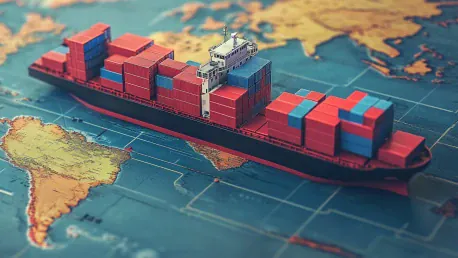As the maritime industry continues to integrate more advanced technologies into its operations, concerns over cybersecurity are becoming increasingly critical. The shift towards enhanced connectivity of vessels, particularly through high-speed Low-Earth Orbit (LEO) services like Starlink and OneWeb, has brought unprecedented vulnerabilities that demand urgent attention and robust solutions.
Increasing Connectivity and Its Implications
The adoption of high-speed LEO services represents a significant leap forward in operational efficiency and crew connectivity within the maritime sector. These advancements have transformed traditional IT systems, facilitating smoother operations and more informed, data-led decision-making processes. However, this transition has also exposed a larger attack surface for cybercriminals to exploit.
Enhanced vessel connectivity has undeniably streamlined maritime operations, enabling improved communication and coordination at sea. Yet, this increased connectivity comes with considerable challenges when it comes to securing operational technologies (OT) and information technologies (IT) networks. Unlike the traditional, less complex communication systems, the new high-speed services require comprehensive cybersecurity measures to counteract potential threats. The integration of smart shipping technologies for cost-saving and efficiency purposes further compounds this issue by necessitating extensive data exchanges between IT and OT networks, thereby heightening vulnerabilities.
Types of Cybercriminals
The maritime industry faces threats from a diverse array of cybercriminals, as detailed in three primary categories. State-affiliated groups and hacktivists often possess motives tied to political coercion, economic gain, or the disruption of critical infrastructures. These actors typically target essential operations with the aim of gathering sensitive information or exerting pressure on governments and organizations.
Criminal organizations, motivated by financial gain, employ highly sophisticated methods, including ransomware-as-a-service (RaaS) models. These entities treat cyberattacks as a business, leveraging networks of affiliated hackers to carry out attacks on a wide scale. Lone criminals, on the other hand, pose threats driven by a range of motivations from financial gain to ideological beliefs or simply the thrill of hacking. Each type of cybercriminal introduces unique challenges and risks that require tailored defense mechanisms to mitigate the impact of their activities on maritime operations.
The Threat of Phishing Attacks
Phishing attacks have emerged as one of the most prevalent cyber threats within the maritime industry. These attacks, typically initiated via deceptive emails and messages, serve as entry points for more severe cyber incidents, such as ransomware intrusions. The increased crew connectivity enabled by high bandwidth services like Starlink has inadvertently elevated the risk of phishing attacks, making cybersecurity awareness and training indispensable for safeguarding human-related vulnerabilities.
Effective measures against phishing attacks involve not only technical defenses but also fostering a cybersecurity-conscious culture among crew members. Continuous education and training programs are essential to ensure that personnel can recognize and respond appropriately to phishing attempts. The adoption of cybersecurity best practices, including secure email protocols and regular phishing simulations, can significantly enhance the industry’s resilience against social engineering tactics used by cybercriminals.
Defensive Measures
To counteract the growing cyber threats, the maritime industry is subscribing to various cybersecurity services, each addressing different aspects of defense. Consulting and training services focus on educating crew and management about potential cyber threats, elevating the overall cybersecurity posture of the sector. These services emphasize the importance of awareness and proactive behaviors in mitigating risks.
Endpoint protection is another critical area, encompassing tools like antivirus programs, anti-spam measures, firewalls, unified threat management (UTM), and endpoint detection and response (EDR). These services aim to safeguard individual systems and devices against malware and other cyber threats. Comprehensive network and infrastructure security measures are implemented to ensure the protection of broader network communications and critical infrastructure elements, maintaining the integrity and availability of maritime operations.
Network and Security Operations
Network and infrastructure security services play a pivotal role in safeguarding broader network communications and critical infrastructure within the maritime industry. The utilization of Security Operations Centers (SOCs) for real-time threat identification and mitigation is proving to be an invaluable asset for maritime companies. These centers offer continuous monitoring capabilities, providing immediate responses to emerging threats.
Maritime companies like Tototheo Global and CyberOwl are at the forefront of offering advanced threat monitoring and management services. Their initiatives underscore the importance of real-time visibility and threat intelligence, enabling companies to stay ahead of potential cyber threats. By integrating sophisticated cybersecurity measures into their operations, these firms are setting benchmarks for the industry, driving the adoption of proactive and defensive cyber strategies.
Integration and Adoption of Cybersecurity Measures
In addition to dedicated cybersecurity services, the maritime industry is increasingly embedding security measures into other digital offerings. Products such as Dualog’s email system include integral security features like malware protection and anti-spam filtering, ensuring comprehensive safeguards are in place.
The degree of cybersecurity adoption varies among maritime companies, influenced by factors such as budget constraints and regulatory compliance requirements. Larger organizations and those operating in high-risk environments tend to invest significantly in advanced cybersecurity protections. Meanwhile, cost-sensitive companies often focus on achieving basic compliance with minimal expenditure. Despite these variations, there is a growing consensus on the necessity of robust cybersecurity measures to protect against evolving threats.
Industry Trends and Movement
As the maritime industry progressively integrates advanced technologies into its operations, cybersecurity concerns are becoming increasingly critical. The reliance on enhanced connectivity of vessels, particularly through high-speed Low-Earth Orbit (LEO) services like Starlink and OneWeb, has introduced new, unprecedented vulnerabilities that need immediate and robust solutions. These new technologies provide better communication and operational efficiencies, but they also expose the industry to potential cyber threats. Hackers and cybercriminals may exploit these vulnerabilities to disrupt maritime operations, leading to financial losses, safety risks, and potentially catastrophic events.
Therefore, it is essential for the maritime sector to invest in comprehensive cybersecurity measures. This includes training personnel, regular system audits, and deploying advanced cybersecurity protocols to protect against these threats. As technology evolves, the maritime industry must stay ahead of the curve to ensure safe and secure operations in the increasingly interconnected digital world of shipping.









